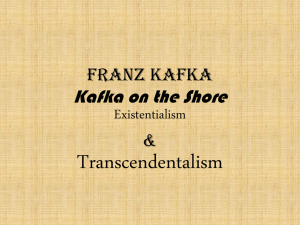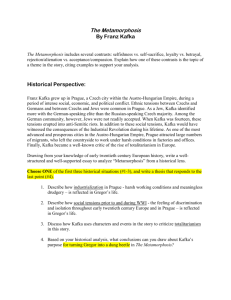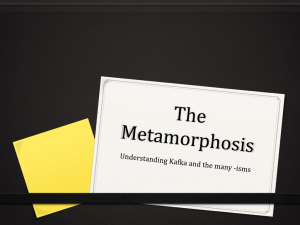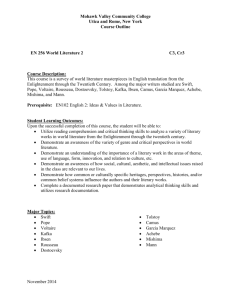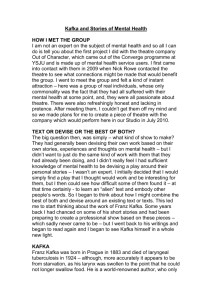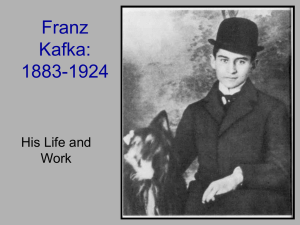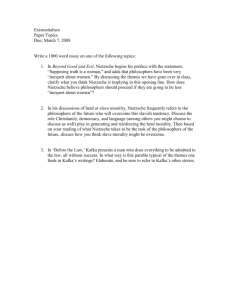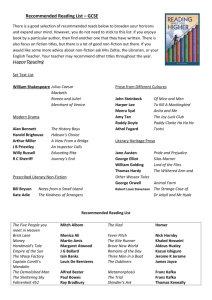Kafka`s `In the Penal Settlement`: Some Psychoanalytic Speculations
advertisement
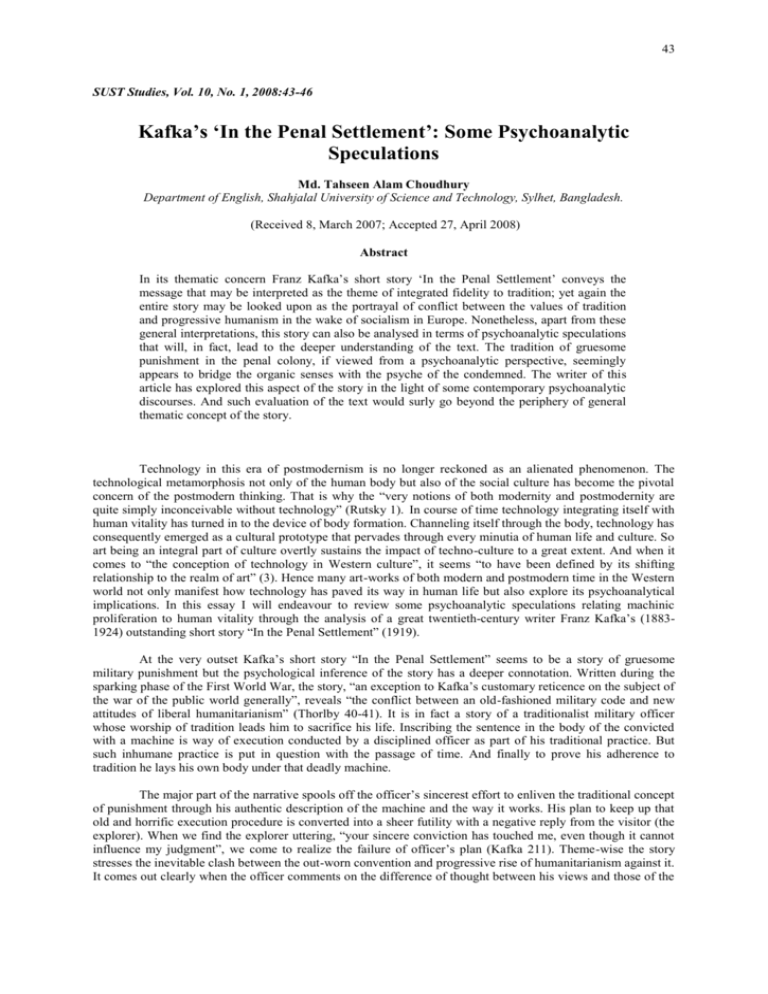
43 SUST Studies, Vol. 10, No. 1, 2008:43-46 Kafka’s ‘In the Penal Settlement’: Some Psychoanalytic Speculations Md. Tahseen Alam Choudhury Department of English, Shahjalal University of Science and Technology, Sylhet, Bangladesh. (Received 8, March 2007; Accepted 27, April 2008) Abstract In its thematic concern Franz Kafka’s short story ‘In the Penal Settlement’ conveys the message that may be interpreted as the theme of integrated fidelity to tradition; yet again the entire story may be looked upon as the portrayal of conflict between the values of tradition and progressive humanism in the wake of socialism in Europe. Nonetheless, apart from these general interpretations, this story can also be analysed in terms of psychoanalytic speculations that will, in fact, lead to the deeper understanding of the text. The tradition of gruesome punishment in the penal colony, if viewed from a psychoanalytic perspective, seemingly appears to bridge the organic senses with the psyche of the condemned. The writer of this article has explored this aspect of the story in the light of some contemporary psychoanalytic discourses. And such evaluation of the text would surly go beyond the periphery of general thematic concept of the story. Technology in this era of postmodernism is no longer reckoned as an alienated phenomenon. The technological metamorphosis not only of the human body but also of the social culture has become the pivotal concern of the postmodern thinking. That is why the “very notions of both modernity and postmodernity are quite simply inconceivable without technology” (Rutsky 1). In course of time technology integrating itself with human vitality has turned in to the device of body formation. Channeling itself through the body, technology has consequently emerged as a cultural prototype that pervades through every minutia of human life and culture. So art being an integral part of culture overtly sustains the impact of techno-culture to a great extent. And when it comes to “the conception of technology in Western culture”, it seems “to have been defined by its shifting relationship to the realm of art” (3). Hence many art-works of both modern and postmodern time in the Western world not only manifest how technology has paved its way in human life but also explore its psychoanalytical implications. In this essay I will endeavour to review some psychoanalytic speculations relating machinic proliferation to human vitality through the analysis of a great twentieth-century writer Franz Kafka’s (18831924) outstanding short story “In the Penal Settlement” (1919). At the very outset Kafka’s short story “In the Penal Settlement” seems to be a story of gruesome military punishment but the psychological inference of the story has a deeper connotation. Written during the sparking phase of the First World War, the story, “an exception to Kafka’s customary reticence on the subject of the war of the public world generally”, reveals “the conflict between an old-fashioned military code and new attitudes of liberal humanitarianism” (Thorlby 40-41). It is in fact a story of a traditionalist military officer whose worship of tradition leads him to sacrifice his life. Inscribing the sentence in the body of the convicted with a machine is way of execution conducted by a disciplined officer as part of his traditional practice. But such inhumane practice is put in question with the passage of time. And finally to prove his adherence to tradition he lays his own body under that deadly machine. The major part of the narrative spools off the officer’s sincerest effort to enliven the traditional concept of punishment through his authentic description of the machine and the way it works. His plan to keep up that old and horrific execution procedure is converted into a sheer futility with a negative reply from the visitor (the explorer). When we find the explorer uttering, “your sincere conviction has touched me, even though it cannot influence my judgment”, we come to realize the failure of officer’s plan (Kafka 211). Theme-wise the story stresses the inevitable clash between the out-worn convention and progressive rise of humanitarianism against it. It comes out clearly when the officer comments on the difference of thought between his views and those of the 44 Md. Tahseen Alam Choudhury new commandant, as he says, “The new man has certainly shown inclination to interfere with my judgements, but so far I have succeeded in fending him off and will go on succeeding” (192). Apart from this thematic concern the story may also be evaluated from a psychoanalytic perspective. We can annotate the events in the story with a cluster of psychological interpretations. Georg Simmel in his essay “The Metropolis and Mental Life” posits that man’s “mind is stimulated by the difference between present impressions and those which have preceded” (Simmel 325). The mental confrontation Kafka portrayed through the restive attitudes of the officer may seem to have a plausible link with Simmel’s view. The officer represents his struggle for continuing his existence in the core of traditional heritage by clinging to the deadly “apparatus”, which any one seems to find impossible to alter “at least for many years to come” (Kafka187). As such, his “habituated regularity” is one that “consumes less mental energy”, and is shaken through the onlooker’s (the explorer’s) disapproval of the penal settlement (187). Eventually the officer realizes that the ending has arrived for the grisly tradition of his Old Commandant saying, “Then the time has come” and the machine by “going to pieces” at last epitomizes the metaphor of psychological change in the notion of capital punishment in the wake of modernism (211, 217). This metaphor of the collapse of the machinic, if mulled over from the explorer’s mental disposition, enunciates what Simmel terms “the resistance of the individual to being levelled, swallowed up in the social–technological mechanism” (Simmel 324). But the same motif of Kafka’s story may have a deeper psychoanalytic elucidation, if it is examined in the light of Walter Benjamin’s perspective of psychoanalysis. To Benjamin “technology has subjected the human sensorium to a complex kind of training” (Benjamin 177). Here he seems to have explored the interaction between technology and human psyche in the age of industrialism and technological growth. And as far as Kafka’s story is concerned, Benjamin’s psychoanalytic speculation may have the following elucidations. In the first place the officer’s blind admiration of the past in “In the Penal Settlement” may reflect his one kind of experience, which is “less the product of the facts firmly anchored in memory than of a convergence in memory of accumulated and frequently unconscious data”(Benjamin15). Throughout the story the officer keeps reflecting on his glorious past because of the continuous union of the data in his unconscious mind, which is commonly termed as the storage of oblivious contemplation and forgotten ideas (Burt, Jones, Miller, Moddie,76). His unconscious mind wakes up under the constant rendition of external stimuli. The “apparatus”, execution of sentence, “the condemned man”-all come as vivid stimuli to agitate the officer’s unconscious mind. His reminiscent words—“How different an execution was in old days!”—also appear to be in a close proximity with what Proust terms “mémoire involontaire” in which “certain contents of the individual past combine with material of the collective past” (Kafka 202 & Benjamin 161). This amalgamation in the officer’s psyche works as an active spur triggering off the influx of recollection in his mind. Moreover, the Freudian explication of the correlation between memory and consciousness may be applied here as a supportive factor. Freud’s elemental rumination—“consciousness comes in to being at the site of a memory trace” and his view on the function of consciousness—“protection against stimuli”—both hypothesize that a conscious mind is far less vulnerable than an unconscious one (Benjamin 162-163). Hence we can assert that the officer in ‘In the Penal Settlement’ projects the impact of the unconscious psyche in his demeanour. Secondly, when Benjamin draws a link between technology and the ‘human sensorium’, he points to the compatible existence of both technology and human psychology. While expounding Marx’s view he has quoted a Marxist statement to articulate the conformity between man and machine: The working conditions make use of the worker; but it takes machinery to give this reversal a technically concrete form. In working with machines, workers learn to co-ordinate “their own movements with the uniformly constant movements of automation” (177). And this complementary relationship between man and machine is another psychoanalytic annotation that Kafka’s story may be imbued with. The punishment procedure in the story gives an impression of a device to reach mental enhancement through bodily perforation. Writing the sentence ‘deeper and deeper for the whole twelve hours’ on the body of the convicted does not merely mean to put end to the life of the convicted but at ‘just about the sixth hour’ it brings the moment of “Enlightenment” in his eyes—a moment after which “the man only begins to understand the inscription, he purses his mouth as if he were listening” (Kafka 197, 198). Benjamin in his critical essay on Kafka remarks that in The Penal Colony, “the back of the guilty man becomes clairvoyant and is able to decipher the writing from which he must derive the nature of his unknown guilt” (Benjamin 133). Here the word “clairvoyant” suggests the performativity of the human senses at the psychic level. Instead of imparting an abstract facet to our psychic order Benjamin endeavours to uphold the inseparable association between the physique and the psyche. Kafka’s ‘In the Penal Settlement’: Some Psychoanalytic Speculations 45 Benjamin’s analysis of Kafka’s works later finds its similitude with the approach of Gilles Deleuze and Félix Guattari who, in a book on Kafka published in 1974, take their exit from the prevalent set concept of “oedipalization” and “theological-metaphysical speculation” in evaluating Kafka (Deleuze and Guattari, ix). This duo of critics prefers to concretize the essence of Kafka’s writings instead of abstract hypothesizing. ‘The reading of Kafka both in Benjamin and in Deleuze and Guattari is determined by the prominence they give to a politics of Kafka which is not “symbolic, allegorical or mythical interpretation” (x). To Benjamin Kafka’s work is like “an experimental machine, a machine for effects” that is irreducible to any “binary” particles; likewise Deleuze and Guattari use “the machine producing effects…in the most concrete sense’ terming it ‘a clustered “proximity” between independent terms” (xi, xv). They shun the theory of ‘transcendence of the law’, “internalization of guilt” or “subjectivity of the enunciation” in analyzing Kafka’s work. The story in discussion may sustain the traces of the said viewpoint. In “The Penal Colony” the machine “works by itself” effectively only when there are harmonized interactions among its different parts (Kafka 186). For such act the machine requires the ‘image of the law only to align its gears and make them function together with “a perfect synchronicity” (Deleuze and Guattar 43). But the same law, when it becomes dilapidated and ineffective in course of time, is turned in to ‘plain murder’ without inscribing the law on the body of the convicted. This is what Deleuze and Guattari posit, because “the form of the law in general is inseparable from an abstract, self-destructive machine and can not develop in a concrete way” (48). The body here fails to produce the effect of the “internalization of guilt” or the “subjectivity of the enunciation”. But the same body comes to a post-structuralist like Judith Butler as the medium of mediating “the scene of a cultural inscription” (Butler 129). The “cultural inscription” here refers to the values of culture inscribed on the body for the purpose of signification. This emergence of “cultural values” that Foucault ascertained in the “inscription on the body understood as medium’ necessitates ‘the destruction of the body” (130). Foucault implies that there is the pre-existence of body and it awaits the inscription on it. The punishment of the sentenced man is accomplished through writing the sentence “upon his body by the Harrow, which ‘is the instrument for the actual execution of the sentence” (Kafka 190-191). This extermination of body as execution has been adopted like a culture in the penal colony where the values of tradition are confronted at the advent of the humanitarian speculations. The explorer’s emphatic “No” to execution procedure shatters the officer’s staunch adherence to traditional values (210). But when the officer himself lies under the destructive machine, he truly proves his allegiance towards the values of the past. And this act strongly echoes Butler’s view that articulates “history is the creation of values and meanings by a signifying practice that requires the subjection of the body” (130). The “practice” that the officer signifies “requires the subjection of the body” to create historical values. And Kafka’s story, if viewed from post-structuralist perspective, may be considered compatible with this doctrine in the sense that the body of the convicted upon which the sentence being inscribed is not prediscursive as in Foucault’s notion. Butler has even exemplified Kafka’s “In the Penal Settlement” in her writing to give a better clarification to her view. A statement by her may be worth quoting here: If the creation of the values, that historical mode of signification, requires the destruction of the body, much as the instrument of torture in Kafka’s In the Penal Colony destroys the body on which it writes, then there must be a body prior to that inscription, stable and self-identical, subject to that sacrificial destruction (130). She disputes over the concept of a “stable and self-identical” body “prior to that inscription”. She asserts that the body has no pre-existential structure; it sustains the inscription on its surface as a medium only when it comes into being with discourse. Here Butler’s reflection also appears contrary to that of Didier Anzieu who finds the body “the bedrock of mind, a collection of several sub-systems” (Anzieu 61-62). His view disapproves the conception of disintegration of body and mind. That is why he opines that the entire psychic system emerges “from a concrete basis in organic functioning” (62). And the story, to another extent, also has this tinge as well as expressed by the officer while describing the punitive process to the explorer, “He’ll learn it corporally, on his person” (Kafka 191). The body will be the way for the convicted to realize the inscription. This penal contraption of the story, as Foucault theorizes in his Discipline and Punish, links the body with the soul produced “by the functioning of a power that is exercised on those that are punished” (Foucaullt 29). The punishment of inscribing the sentence on the body in “In the Penal Settlement” signifies “the prohibitive law as their very essence, style, and necessity” (Butler 134). Foucault decodes the existence of soul as something perceptive rather than a mystic illusion. Every point of punishment in the colony relates itself to 46 Md. Tahseen Alam Choudhury the soul through body. And the subjection of the pre-existent body manifests not the internalization but the incorporation of the law, what Butler defines as the emergence of “cultural values” (130, 134, 135). The “condemned man” in the story through his body as “medium” thus begins to “decipher the script with his wounds” transcending the mere symmetry of physical torture. Thus the story evolves an ambience of psycho-corporal association in which technology has been employed as the key ingredient. And this association also highlights the compatible existence of technology and psychology and the prevalence of the body as the medium of communion. A varied set of interoperations of the story in terms of the schools of the metaphysical, the pre-post structural and the post structural lead to this psychoanalytic speculation of it. References [1] Anzieu, Didier, “Interview Four: The Body”, in A Skin for Thought: Interview with Gilbert Tarrab on Psychology and Psychoanalysis, London, Karnac, 1990. [2] Benjamin, Walter, “On Some Motif of Baudelaire”and “On The Tenth Anniversary of his Death”, in Illuminations, ed. Hannah Arendt, trans. Harry Zohn, London: Cape , 1970. [3] Burt, Cyril. Ernest, Jones. Miller, Emanuel. Moddie, William, “The Power of the Unconscious” in How The Mind Works, ed. Cyril Burt, London: George &Unwin Ltd, 1935. [4] Butler, Judith, “Bodily Inscriptions, Performative Subversions” in “Subversive Bodily Acts”, Gender Trouble: Feminism and the Subversion of Identity, New York, Routledge, 1990. [5] Deleuze, Gilles and Guattari, Félix, ‘Foreword The Kafka Effect by Réda Bensamїa’ in Kafka Toward a Minor Litetrature Theory and History of Literature Vol-30 trans. Dona Polan, Foreword. Réda Bensamїa, Minneapolis, University of Minnesota Press, 1986. [6] Foucaullt, Michel, “The Body of the Condemned” in Part one- ‘Torture’, Discipline and Punish, trans. Alan Sheridan, London: Penguin, 1977. [7] Kafka, Franz, “In The Penal Settlement” in In The Penal Settlement Tales And Short Prose Works trans. Willa And Edwin Muir, London, Secker And Warburg, 1949. [8] Rutsky, R. L, “Introduction The Question Concerning High Tech”, High Technē Art and Technology from the Machine Aesthetic to the Posthuman, London, Universality of Minnesota Press, 1999. [9] Simmel,Georg, “The Metropolis and Mental Life”, On Individuality and Social Media: The Extensions of Man, Chicago and London: Chicago University Press, 1971. [10] Thorlby, Anthony, “The Short Stories”, Kafka: A Study, London, Heinemann, 1972.
